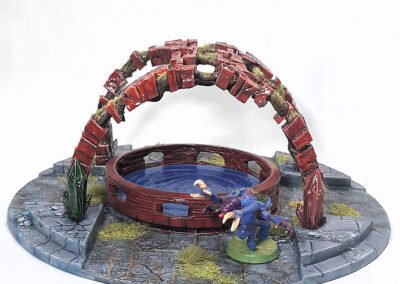The Game-Changing Guide to Priming Miniatures: Tips and Tricks from a 35+ Year Veteran
When it comes to priming miniatures, it is one of the most critical steps you can’t afford to skip. After over 35 years in the hobby, I’ve learned that a well-primed miniature can be the difference between a flawless finish and a model that looks, well… less than perfect. In this guide, I’ll walk you through the ins and outs of priming miniatures, from my personal experiences to tips for getting that smooth, even coat every time.
And remember, if you’re looking for high-quality, ready-to-go miniatures but don’t have the time to paint them yourself, check out dressart3d.com. There, you can find expertly painted miniatures for all your tabletop gaming needs—perfect for those who want beautiful pieces without the hassle of painting.
Why Priming Miniatures is a Must
Setting the Stage for a Perfect Paint Job
Priming miniatures is like laying the foundation for a house. Without a solid base, everything else falls apart. Proper priming creates a smooth surface that helps your paints stick evenly, ensuring better coverage and a more professional-looking finish. Skip this step, and you risk having paint peel off or looking blotchy and uneven.
My Personal Journey with Priming Miniatures
I still remember my early days of miniature painting when I didn’t realize the importance of priming miniatures. I’d go straight into painting, wondering why the colors didn’t pop and why my minis always looked… off. Then I read an article about priming in White Dwarf magazine, and I gave it a try. The difference was night and day! From that moment, priming became the second commandment of my painting process, right after cleaning my miniatures.
Tools of the Trade: How to Prime Miniatures Like a Pro
Airbrush, Paint Brush, or Spray Can?
There are several ways to prime your miniatures, but not all methods are created equal. Let me break it down:

Blog article Secrets to Priming Miniatures @ dressart3d.com
Airbrush: The Smooth Operator
Using an airbrush is the first method for priming. It offers the smoothest and most even coverage, making sure that every little detail on your miniature is highlighted, not hidden. The airbrush also allows for more control over how thick the primer is applied, which helps prevent clogging any of the miniature’s details.
Pro Tip: Always thin your airbrush primer. This ensures that the primer flows smoothly without gunking up your model. Also make sure to prime in layers, one layer at a time. Leave the first layer to dry and then apply another one if need. There is not hurried to cover the miniature with colour all in one go. Remember that this will be the first layer of paint on the plastic surface of your miniature. Give it time to stick well, again one layer at a time.
Spray Can: The Convenient Choice
Don’t have an airbrush? No worries! A regular spray can works great as long as you’re careful. Just make sure you’re not holding the can too close to your miniature (more on that later). I often use matte black or white spray paints instead of dedicated priming colors, as I find some primers in spray cans are a bit too thick for my liking.
Pro Tip: Always test your spray can on a piece of cardboard or an old miniature to make sure the paint isn’t too thick. Thin layers work best!
Paint Brush: The Backup Plan
While I wouldn’t recommend using a paintbrush for large models, it’s a decent option for touch-ups or small sections. However, brush strokes can leave marks on bigger surfaces, which can be hard to hide with subsequent layers of paint.
Choosing the Right Primer Color for Priming Miniatures
Black, Grey, or White?
One of the most common questions I get is: *What color should I use to prime my miniatures?* The answer depends on the look you’re going for:
Black Primer: Perfect for Darker, Shadier Miniatures
If you’re working with darker colors or want natural shadows in your mini’s crevices, black primer is your friend. It’s excellent for adding depth to areas your paintbrush can’t quite reach. But be careful—light colors like red and yellow have a hard time covering black, so you might need to add a white or grey layer on top.
White Primer: Bright and Bold
White primer is great if you’re planning to use bright colors. It makes red, yellow, and orange pop, giving your miniature a more vibrant finish. Personally, I use white on most of my miniatures because it helps me avoid the frustration of constantly having to reapply lighter colors.
Grey Primer: The Neutral Ground
When you’re unsure which way to go, grey is a solid middle-ground choice. It offers balance between shadow and brightness and gives you more flexibility in your color choices.
Priming Miniatures Techniques: Step-by-Step

Blog article Secrets to Priming Miniatures @ dressart3d.com
Now that you’ve got your tools and color choice down, let’s talk technique. **Priming miniatures** isn’t just about spraying a miniature until it’s covered. There’s an art to it.
1. Maintain the Right Distance
When using a spray can or airbrush, always keep about half an arm’s length between the nozzle and the miniature for a spray can. With an airbrush you can get closer depending of the pressure regulation of your compress. Here you will have to experiment a bit. Too close, and the paint will pool; too far, and the primer will dry before hitting the miniature, leading to a grainy texture.
2. Mount Your Miniature
Here’s a trick I picked up early on: stick your miniature onto a long dowel or stick using Blu Tack. This way, you can rotate it without touching the mini and smudging the primer. This trick alone improved my priming tenfold.
3. Prime One Miniature at a Time
I know it’s tempting to batch prime a bunch of minis, but trust me—focusing on one at a time allows you to reach all the angles and details. Trying to do too many at once almost always results in missed spots or uneven coverage. Prime a layer on the first miniature, while it dries start the second, while the second dries, start the third and so on. When you finished with the last, return to the first miniature and repeat the priming till you are satisfied with the paint coverage on all miniature you have.
4. Start with Hard-to-Reach Areas
Begin priming in the spots that are harder to reach, like the underside or the upper side. This will allow you to spray some extra layers without compromising the main part of the miniature. Once these parts done it will be easier to cover the easier parts to reach like the front and back which will be already partially covered with your initial priming of the under and upper sides.
5. Avoid Over-Priming
Don’t try to cover the entire miniature in one go. Use short bursts of spray and let each layer dry before adding more. It’s better to apply 2-3 thin coats than 1 thick one. A thick coat will clog details and ruin all the hard work you put into cleaning your miniature. Small short bursts of spray will always yield better results than full long ones. You will need a bit of practice to learn how to time your spray burst but you will surely get better at judging when to stop spraying. Starting will small short bursts will surely help you in this process.
Advanced Techniques: Zenithal Priming Miniatures
What is Zenithal Priming?
Zenithal priming is an advanced technique that mimics natural lighting by layering multiple primer colors (usually black, grey, and white) on a miniature. It creates automatic highlights and shadows, making your painting job easier down the line.
How to Zenithal Prime
- Start with Black Primer: Cover the entire miniature in black primer.
- Apply Grey at 45 Degrees: Once the black dries, spray grey primer at a 45-degree angle to create mid-tone shadows.
- Top it Off with White: Finally, spray white primer from directly above (or slightly above) to highlight the top surfaces, giving a natural lighting effect.
Zenithal priming is a technique I use on more complex or detailed models when I really want to enhance the shading and highlights. It’s an advanced method, but once you’ve mastered basic priming miniatures, it’s definitely worth giving a shot.
Safety First: Don’t Skip Protection While Priming Miniatures
Whenever you’re using spray cans, safety should always be a priority. Spray paint contains chemicals that aren’t great for your lungs, so always wear a proper mask. If you can, prime outside or in a well-ventilated area to avoid inhaling fumes. And, of course, protect your eyes and hands with goggles and gloves.
Practice Makes Perfect: Start Small
If you’re new to priming miniatures, start by practicing on cheaper or less detailed miniatures. This will help you get a feel for the process before you tackle more expensive or intricate models. I can’t tell you how many cheap miniatures I ruined when I first started, but those mistakes helped me perfect my technique over time.
Don’t Have Time to Prime and Paint? Check Out Dressart3D
Let’s face it—priming miniatures and painting can be a time-consuming process. If you’re strapped for time or just want a high-quality, unique miniature for your tabletop gaming, check out dressart3d.com. They offer professionally painted miniatures that are perfect for collectors or gamers who want to impress at their next game night without spending hours behind a paintbrush.
Conclusion: Master the Art of Priming Miniatures
Priming miniatures is one of the most important steps in miniature painting, and getting it right can make a world of difference in your final result. Whether you’re using an airbrush, spray can, or even a paintbrush, the key is patience and technique. And don’t forget—practice makes perfect!
If you’re not ready to dive into the world of priming miniatures and painting, or just want stunning miniatures without the effort, check out the beautifully painted miniatures at dressart3d.com. Whatever path you choose, enjoy the process and happy painting!
Thanks with a Gift!
Thanks for sticking with this long read. If you managed to arrive to this point I sincerely think that you found this reading an interesting one and I really appreciate it. As a small token for your interest, may I remind you that if you simply create an account with our online show you will be instantly given a one time, no expiry 10% Discount Coupon. You will be able to find it in the coupon section of the My Account Section in the links section above.
Thanks for appreciating our Art!



















I’ve been doing okay with priming, but I never tried zenithal priming before. Your instructions were so clear, I’m excited to give it a shot
I thought I knew how to prime until I read this. The zenithal priming section was especially helpful—never tried that before
Been painting for about a year, and I still learned a lot! The distance and layering techniques for priming are game-changers.
I’ve been painting for a long time, but this article made me rethink how I approach priming. The attention to detail is brilliant. Great job
Interesting to see that are different opinions here too. Thanks for the comments.
Love the simple but detailed way you explain yourself. Grate tips to remember.
Very very useful tips I will keep in mind. Thanks!
There are some really good tip in you priming article that I will follow. Thanks!